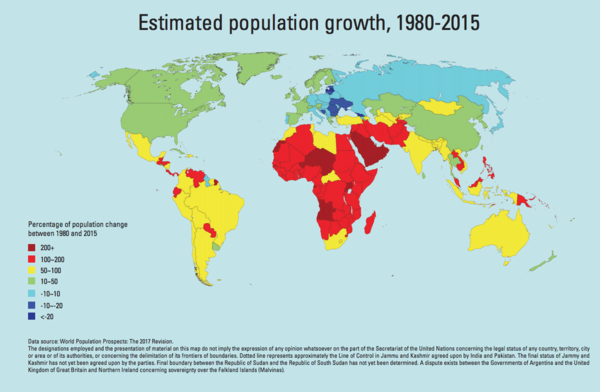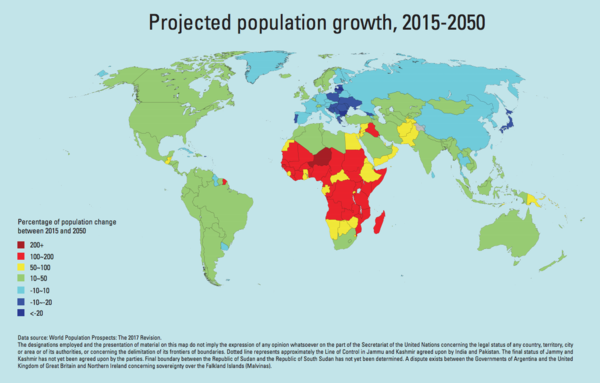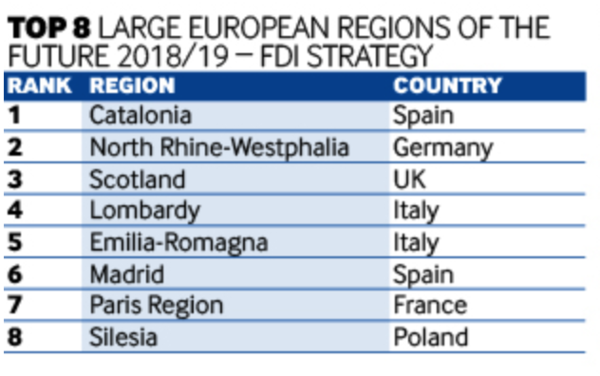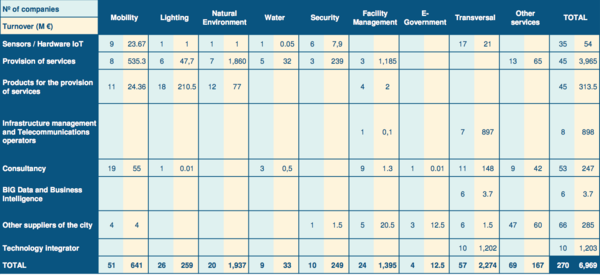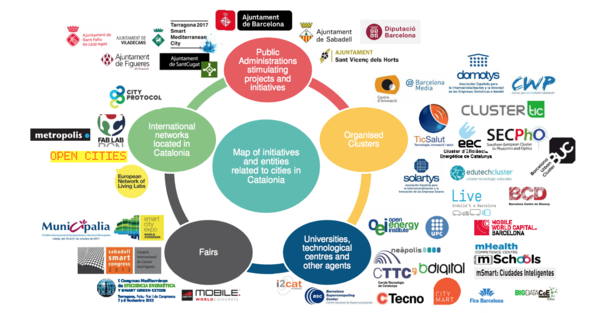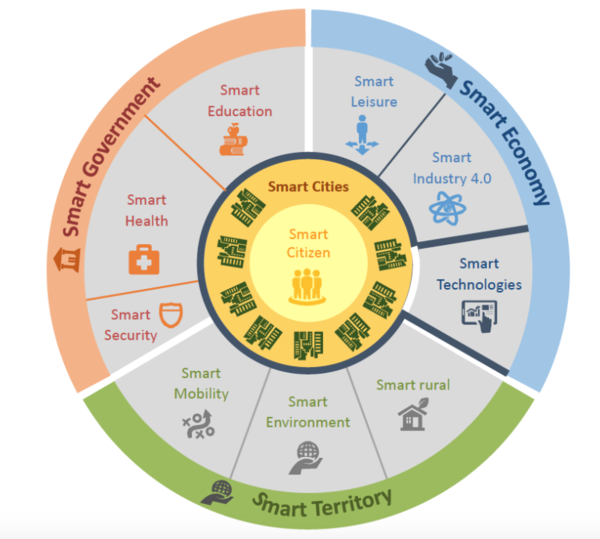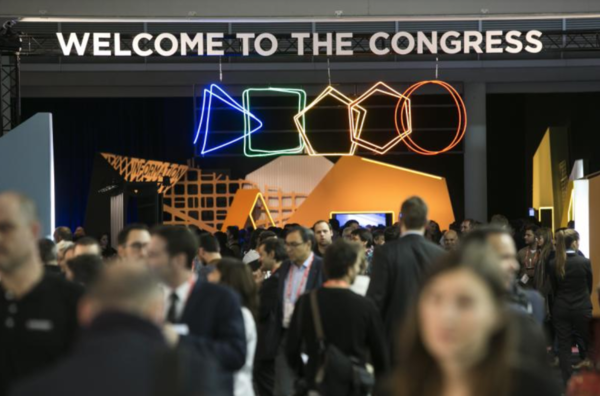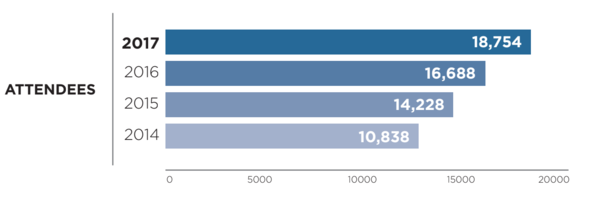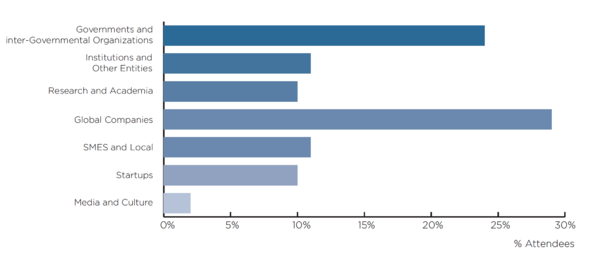Abstract
The business sector dedicated to smart cities is growing and increasingly offers more business opportunities in Catalonia, representing today a 3% of the Catalan GDP.
Within this business ecosystem, events of international reference such as the Smart City Expo World Congress place Barcelona as a meeting point for professionals and experts in cities at an international level.
The smart cities sector represents an opportunity for business development for companies already located in Catalonia, and can become a driving force for talent through the combination of the Barcelona brand and the opportunities offered by the SCEWC.
1. Introduction: urbanism challenging cities and smart cities
Cities have always been places of opportunities: centres of exchange, commerce and trade. They have always worked as economic growth drivers within their countries.
In the last six decades of the twentieth century, the world population has gradually become concentrated in urban centres, a phenomenon that is taking place drastically and rapidly in developing countries. According to the forecasts of World Cities Report, published by the United Nations in 2016 it is estimated that almost 55% of the world population lives in cities where 70% of the global GDP is produced. In 2030, cities are projected to welcome 60% of the world inhabitants. In 2016, there were 31 “megacities”, cities with more than 10 million inhabitants. It is estimated that this number will rise to 41 by 2030 (United Nations Report, 2016: 2-5).
Source: United Nations World Population Prospects: The 2017 Revision
In this scenario, the role of cities will be decisive in responding to the great challenges of the 21st century: climate change, social equity, urban development, sustainable mobility, economic development and the demand for greater citizen participation.
Smart Cities emerged around 2007 as a new paradigm to respond to these challenges, wanting to holistically include various concepts that marked the last stage of the 20th century such as sustainable cities, digital cities, innovative cities, equitable cities, and cities open and participatory.
Smart Cities were created by the combination of four trends. Firstly, the impact of mobile phones and the internet to have information in real time anywhere, which applied to the city has a great potential for innovation. This ability to communicate devices of any kind is what we know today as the Internet of Things (IoT). Secondly, the need to change models to develop a more sustainable city, from mobility to the production of renewable energy. The third trend was the research for efficiency in the management of the city to guarantee and improve the quality of services, and forth, the demand for greater participation by citizens.
Initially, it was the industry that promoted the concept of Smart Cities proposing approaches oriented to technological solutions, energy production and sustainable mobility. However, today, this leadership has been shifted towards cities that promote urban innovation as a clear transformative axis of cultural changes and participatory and collaborative management models. Cultural changes such as the development of shared-use services, driven by emerging generations with less attachment to the possession of goods, like the circular economy, which promotes the reuse of materials. Moreover, the collaborative city (Co-City), promotes collective intelligence thanks to the collaboration between the different actors and the active involvement of citizens.
All these processes of urban innovation are driven by leading cities such as Amsterdam, Copenhagen, London, Vienna, New York, Boston, Medellin, Sao Paulo, Toronto, Singapore, Seoul, or Barcelona, as well as Eindhoven, Bristol, Manizales, Rosario, Jakarta, Bandung, L'Hospitalet or Sant Cugat. It is a global movement in which each city has to establish its road map according to its own challenges and priorities. Smart City is more a path than a destination.
This paper aims to explore the possibilities that the smart city field offers in terms of business opportunities in Catalonia.
2. Smart cities: a global movement
Smart cities are the urban centres that seek sustainable development, the improvement of the quality of life of the residents, the participation of the citizens and the efficiency of the resources through the application of digital technologies. It is a city model that offers business opportunities in areas such as administration, government, training, network connection, mobility, environmental quality or urban regeneration, among others.
In this scenario, to what extent can intelligent cities be a field to explore for companies and investors? Bank of America Merrill Lynch's study 21st Century Cities: Global Smart Cities Primer explains smart cities as a "perfect storm of disruptive technologies" to meet demographic, economic, environmental, social and infrastructure needs. The report considers that cities will be positively transformed by technologies and companies related to the smart city market (broadband coverage, IoT, Big Data networks, artificial intelligence, cloud services…). (Bank of America, 2017: 54-57)
There is a wide potential of business in the smart city market, which would have benefits both for the cities and its citizens. Roland Berger published the report “Smart city, smart strategy” in 2017 about the growing current state of the smart city market worldwide, where it mentions that the global market for smart cities solutions is set to expand by 13% over the coming decade, from just under USD 13 billion in 2017 to a forecast USD 28 billion in 2023.
The Asia-Pacific region will grow at an average of 16% a year being the one that will grow faster. Europe will moderately grow around 13% while North America and Latin America will only grow an average of 11%. (Roland Berger report, 2017: 11).
To make the most of this potentially expanding market, companies and cities need to develop a strategic approach that allows a more holistic comprehension of the city and its needs rather than a fragmented one. In this scenario, companies propose global and integrated solutions for cities, as well as start-ups that take advantage of the market gaps delivering ad-hoc solutions to cities. As the report mentions, government infrastructure and service providers play a relevant role since they own the city infrastructure and are consumers of smart city solutions as well.
The report published by Bank of America Merrill Lynch analyses the impact of the smart cities on the economy and reveals that the market of smart cities will mean 1.29 trillion euros by 2020, and suggests that the number of Internet users would go from the current 2,900 million to 4,000 million by 2020.
Therefore, the development of smart cities has been configured as a business opportunity for SMEs around the world, which can witness fast growing results as well as internationalization actions thanks to governments and public institutions support.
Another report referred to this issue by Dominique Bonte entitled “The role of smart cities for economic development”, published by ABI Research, mentions that “cities need to start optimizing their smart cities strategies in view of the operationalization of these economic benefits based on detailed guidelines and checklist tools”:
• Define priorities and strategies based on an economic development strengths, weaknesses, opportunities, and threats
• Set up processes supporting frictionless interaction with supplier ecosystems
• Optimize based on economic variability according to regional and city size differences (Dominique Bonte, 2018: 2)
In this report, there are different economic indicators to measure the impact of the smart city business on the economic development. On the first place, by its global GDP, the monetary market value of all final goods and services produced in a given year. Employment is also a crucial indicator of development, especially for cities in which the economy is mainly organized around labour-intensive service industries. At last, the city development is also an indicator particularly in inequality reduction, improvement of education, etc. (Dominique Bronte, 2018: 4-5)
2.1 Barcelona, pioneer in urbanism and smart cities
Barcelona has a worldwide reputation for being at the forefront of urban technological innovation. The urban transformation of the city has been developed in accordance with the historical and territorial evolution of the city, and with other defining factors in public space, such as architecture, urban infrastructure and the adequacy and maintenance of the city. The urban development of Barcelona has been constant since its founding in the Roman period to the present, although it has been since the 19th century that it has been accentuated thanks to the Eixample plan, designed by Ildefons Cerdà, and the later aggregation of bordering municipalities. Cerdà's project was quite innovative for the time, especially regarding the delimitation of green spaces and service areas, taking into account both functional and leisure aspects and care. Cerdà accompanied his project of various reports and statistical studies in which he showed his urban theory in his Teoria general de la urbanització. The book mentions the “science of building cities”, considered a phenomenon which became a new discipline with a broad economic, social and cultural impact on the life of the people of the city.
Alongside, the city has internationally renowned architecture universities such as the Superior Technical School of Architecture of Barcelona (ETSAB), the largest and oldest in Catalonia. The school is leading education in landscaping in Spain and stays in collaboration with the most prestigious schools in Europe. From the beginning, ETSAB continues to exert a continuous influence on the development and design of Barcelona and maintains a permanent dialogue in the debates generated by the city through its critical capacity and intellectual influence.
Nowadays, Barcelona is again a benchmark for the new paradigm of urban planning with a cross-stitching look at Smart Cities, and other new trends impact the city's design, according to a recent report published by Philips Lighting and SmartCitiesWorld.
The Catalan city is mentions as the a prime example of smart city, since it has created an estimated 47,000 jobs through the implementation of Internet of Things (IoT) systems, saved EUR 42.5 million on water and generated an extra EUR 36.5 million a year through smart parking2. (Paul Simpson – Philips and Smart Cities World Report, 2018; 8-16)
3. Catalonia, a region where to invest
Catalonia has been historically a trading nation and part of its economy has been built upon international commerce due to its location in the Mediterranean.
The municipalities of Catalonia have created trade hubs that have helped the revitalisation of urban centres and have allowed the combination of traditional trade with international brands.
The Regional Innovation Report of Catalonia (2016) points out that the Catalan industry has been known for its high level of adaptation to new technologies and customer needs. The Financial Times recently rated Catalonia as the best region of the south of Europe to invest.
Source: fDi’s European Cities and Regions of the Future 2018/19 – FDI Strategy (Regions)
The article mentions some of the advantages of investing in this region. The 146 companies that invested in Catalonia during 2017 have access to an aftercare manager at CT&I, who holds meetings with all companies’ post-investment to assess their requirements and challenges and help find solutions. At the same time, it stresses out that companies can also participate in networking events organised by CT&I, as well as international trade fairs and roadshows such as the Mobile World Congress or the Smart City Expo World Congress, which clearly contribute to the situation of Catalonia as an innovation and technological hub. (Financial Times Article, 2018)
The Regions Report also stated that the Strategy for Smart Specialisation of Catalonia (RIS3-CAT) focuses in different enabling technologies that have helped the region become one of the major players internationally in areas like photonics or 3-D printing. (Regional Innovation Report of Catalonia, 2016).
3.1 The Smart City market in Catalonia
Catalonia has been pioneer in the adoption smart solutions for the management of its cities. A report published in 2016 by Acció, the agency of the Generalitat de Catalunya that supports the competitiveness of Catalan companies, proves that there is an ecosystem of smart cities. In this last publication about the smart city activity in Catalonia, it is mentioned that in 2015 there were more than 270 companies working in the smart city field that were invoicing 36,650 M € and employing 116,163 workers. This numbers represented the 3% of the Catalan GDP back in 2015. (Acció, 2016: 3)
The report situates the city of Barcelona as the one that concentrates the highest number of companies working on this field, being 84% of smart city businesses, followed by Lleida (6%) and Girona (5%). From these companies, 51% of them are exporting and 17% have affiliates abroad. There is a high percentage of export in companies of equipment and products, services like big data and products of Hardware and IoT. (Acció, 2016: 3)
Source: Cluster Development, based on SABI and interviews.
In order to explain the reasons why there is a development of the business activity in the smart city sector in Catalonia, the report observes that the presence of clusters, technological hubs, research and universities as a key to boost this expansion. Apart from them, there are other different actors and initiatives related to the implantation and execution of smart city projects in Catalonia:
- Public administration: city halls, provincial councils, etc.
- International networks located in Catalonia: fablab, open cities, European Network of Living Labs, etc
- Clusters: BDC, Tic Salut, etc.
- Universities and research centres: CTecno, i2cat, UPC, etc.
- Fairs: Municipalia, or the Smart City Expo World Congress
Source: Cluster Development based on Mercantile Registri data, SABI and inerview
The report also mentions that Catalonia has 64 cities with more than 20.000 citizens. This situation leads to the establishment of an ecosystem of smart city companies to work and investigate how new technologies can be developed in order to improve citizens’ quality of life. (Acció, 2016: 5)
According to this report, the three main sectors where Catalan companies are working related to smart city solutions are also pointed out: waste management, mobility and lightning. From these companies, 82% from them are SMEs and 74% of these companies are consolidated companies established around 10 years ago. (Radiografia del sector empresarial de les smart cities a Catalunya, 2016: 1-20).
3.2 Smart Strategies in Catalonia
SMARTCat
In 2014, Catalonia created SMARTCat, a roadmap to guide in the implementation of the smart city projects in Catalan municipalities, and coordinate local and supralocal initiatives, different offers to support businesses and promote ‘smart’ initiatives on a countrywide basis.
Within the framework of the SmartCAT strategy of the Generalitat of Catalonia the SmartCAT Observatory is launched to offer a comprehensive and up-to-date vision of Smart projects and initiatives that are being carried out in the Catalan territory. This strategy had different action areas:
- The Smart City area aimed to increment the collaboration between the administration and the private sector, encouraging the roll-out of smart city projects in Catalonia.
- The smart Land areas aimed to stimulate the collaboration between agents to leverage a technological climate where to develop the smart city projects created by the Generalitat within the territory.
- Smart Economy pursued to strengthen the industrial growth while promoting business opportunities.
- The Smart Government was directly linked to an Open Government strategy that stablished bidirectional communication between the municipality and the citizens, clearly committed with issues such as transparency and participation.
- The Smart Citizen aimed to encourage the stimulation of smart citizens that could make decisions regarding their cities, regions and countries. Digital training and the improvement of public services was included in this strategy in order to motivate their participation.
Source: Smart Catalonia http://smartcatalonia.gencat.cat/ca/smartcat/que_es/
In 2016, the Smart Catalonia Strategy receives a new impulse with the objective to turn Catalonia into a Smart Country of international reference. This program integrates and coordinates the local and regional initiatives while taking advantage of technology, digital information in order to boost the innovation in different areas such as the public services, sustainability and promote economic growth. (SmartCAT, 2017: 2-16)
Within its new areas of action, the program includes a project to promote technological vocation among young people, the creation of a research and innovation program in advanced technologies, the creation of a Big Data program in the Generalitat de Catalunya and the design of a technological platform of “Smart Catalonia” for Catalonia.
The Smart Catalonia strategy has four different sources of funding.
- The public-sector projects related to the Government of Catalonia and all the projects related to the local administrations participate in the economic supply of the strategy.
- The private sector projects driven by a public-private partnership or only by the private sector. These are projects that help attract international investments.
- The H2020 which participates with a budget of 2.000M € for Catalonia and works as a framework where to be alienated in terms of priorities and projects.
- The RIS3CAT, the Research and innovation strategy for the intelligent specialization of Catalonia, participates in the funding and participated in the industrial, territorial and social projects.
In order to stablish a legal framework where to start implementing all these initiatives, different government agreements and specific regulation for the impulse of the digital society were signed. (SmartCAT, 2017: 2-16)
4. The Smart City Expo World Congress: a networking opportunity to connect worldwide
As aforementioned, Catalonia has different initiatives and organisations working in the smart cities field (clusters, public administration, Acció program, etc.). Among them, the trade and international networks play an important role in Catalonia since Barcelona hosts one of the most international city event worldwide: the Smart City Expo World Congress, and the most international technological event worldwide: The Mobile World Congress.
The Smart City Expo World Congress, organized by Fira de Barcelona, is the international leading event for cities, committed to boost the implementation of the global agendas and support the development of our cities. The event aims to be the place where urban power meets, where cities share strength and challenges and where partnerships are established. It is a place for research, best practices and potential common solutions sharing.
Source: Smart City Expo World Congress www.smartcityexpo.com
Since its first edition in 2011, this event has managed to become the global benchmark event on cities development. It has succeeded in becoming a referential global meeting point for public administrations, companies, social entrepreneurs, start-ups, research centres and citizens' initiatives that come together to show, learn, share, network and gather inspiration to support the development of cities.
The great challenge of cities is how to manage their radical growth. In Europe, cities are contained by their limitations of physical growth, but in Asia and Latin America the large cities are growing exponentially. The Smart City Expo World Congress spotlights the world-wide debate on how to plan the growth promoting the development of big cities versus megacities.
In the recent years, the Smart Cities sector has evolved rapidly. During its last seven editions, the Smart City Expo World Congress has been a thermometer of the maturation of the sector. In the last 2017 edition, more than 18.700 people attended to the congress, which hosted more than 700 cities, 420 speakers and 675 exhibitors. During the last editions, the number of attendees has rapidly increased. According to the Smart City Expo World Congress 2017 Report, the attendees represent different areas related to the city (governments, academia, institutions, etc.) with a higher presence of companies and governments.
Source: Smart City Expo World Congress 2017 Report
Source: Smart City Expo World Congress 2017 Report
In all editions, the Catalan Government has actively taken part in the events promoting the participation of Catalan companies within the Smart City Expo World Congress.
During the 2017 edition, 20 Catalan companies and entities shared stand with the Catalan Government, in order to attend the congress and use the networking opportunities offered by the event. Innovative and advanced technologies, competitive business service providers and talented professionals make Catalonia a leading business and investment hub. This is aligned with the Smart Catalonia Strategy, designed to make Catalonia an international smart region benchmark, taking advantage of digital technology and information to encourage innovation in public services, foster economic growth and promote a more intelligent, sustainable and integrative society.
This relationship between the city, its government and companies creates a unique ecosystem that opens up many business opportunities, especially for technology companies related to the Smart Technology City Market, which has been proved to be an evolving one.
As Jordi Arias from the department of the Genearlitat de Catalunya Acció mentions: “Catalonia can build on Barcelona's international leadership, and extend the networking concept connecting cities that have significant experience in working in smart concepts. These smaller cities, highly agile and dynamic, are very common in Catalonia, and count on the support of the Catalan Government, which presented during the event the Smart CAT initiative, a network of intelligent cities of the future”.
4.1 Barcelona at the spotlight of innovation and talent attraction
The city of Barcelona has hosted the Smart City Expo World Congress since its first edition being aware of the advantages and opportunities this event means for the city and the Catalan cities, companies and administrations that participate in the event.
The City Council presented in 2016 the Barcelona Digital City Plan 2017-2020 to address how technology and data can help solving urban challenges, driving technological sovereignty and fostering an inclusive digital economy based on the collaboration between companies and public administration. (Smart City Expo Report, 2018: 13)
During the event in 2017, five panels of the congress discussed the main challenges Barcelona is facing in the City Council booth. Different presentations took place regarding topics like housing, mobility, social development, sustainability and participation. The creation of such spaces within the event represents a space for networking and collaboration between stakeholders in order to create public-private-partnerships. The Smart City Expo World Congress generates the possibility of different synergies between cities, companies and administrations, creating areas to discuss, reflect and share between all the participants.
This event, along with other internationally renowned ones, like the Mobile World Congress, situate the city of Barcelona in the spotlight of innovation and openness. This is proved by the European Digital City Index 2016 published by Nesta and the European Digital Forum Think Thank, that places Barcelona among the ten most attractive European cities for digital entrepreneurship. One of the reasons stated in the report is the rise of digital start-ups being helped by the city authorities as a goal to help Barcelona become a leading digital city. The initiatives mentioned include smart traffic management, free public Wi-Fi, data openness initiatives and the promotion of international events (Nesta UK, European Digital City Index, 2016).
5. Conclusions
Nowadays, in the context of globalisation, companies are allowed to settle in almost every city. Therefore, talent attraction is crucial to generate innovation in a city. Thus, many cities and regions battle for talent attraction of new companies. They are a great asset when they are well integrated in the city, when they contribute with knowledge and create new jobs for citizens.
Barcelona is well recognized as one of the leader cities in the world in Urban Innovation and Smart Cities. There is an important ecosystem in Catalonia combining big companies with wide experience in urban services and SMEs and entrepreneurs with technological and innovative urban solutions.
Companies help stimulate the economy of the city with their projects. In that sense, the collaboration between companies and city halls to move in that direction is crucial in order to create a better future for cities. This has been recently witnessed in Barcelona with the Metropolis:Lab project, created between SEAT and Barcelona City hall. The company will open and run an innovation lab that will focus on the intelligent management of traffic and various applications related to the connected car. More than 50 representatives from companies and institutions based in Catalonia participated in the first lab during last July. This is an example of cooperation between the administrations and the private sector to leverage innovation and talent in the city.
Another example that aims to boost the city possibilities and attract business, is the initiative to make Catalonia a European 5G hub, recently launched by the Regional Government of Catalonia, Barcelona City Hall, Mobile World Capital Barcelona, the i2CAT Foundation, the CTTC, Atos and the UPC.
The 5G technology will entail technological change and the creation in smart environments and advanced industries serving the public and emerging economic sectors. The idea is also to facilitate access to the Internet of Things (IoT), paving the way for a new generation of ground-breaking services such as driverless and connected vehicles, services based on drones, the 4.0 industry and access to remote e-health services, all improving user experience. The rollout of 5G will bring about a technological transformation in services and infrastructures, reduce the digital divide and generate opportunities for new generations. This initiative of developing the 5G in Catalonia will be key to develop services for the Smart Cities, and this initiative put Barcelona and Catalonia as leaders in the new technological scenario.
In this scenario, the smart city sector can work as an innovation laboratory where to rethink the city. There are vast possibilities where to connect and transform the city using smart solutions that transform and optimize our lives. The current debate about the possibilities and implementation of Smart Cities is a sign of its vitality. Smart Cities start from a need for change towards more sustainable models. They respond to a reality that is already present, shown by the diversity of movements and initiatives that are taking place in the world, which indicate how our relationship with the city is changing. We must look at Smart Cities as an opportunity to work and invest to reach more efficient and sustainable cities, but also more inclusive ones and with a better quality of life.
Combining the recognition of Barcelona, the Catalan ecosystem of companies and research centres, the collaboration between public and private Sector and the celebration of Smart City Expo World Congress, and the economic size of the Smart Cities development, Smart Cities is one of the drivers of the Catalonia economical drivers.
Bibliography
Reports and Papers:
bronte, Dominique: Bronte, Dominique. Role of Smart cities for economic development. ABI Research, 2018. https://www.chordant.io/white_papers/abi-research-role-of-smart-cities-for-economic-development
generalitat de catalunya, Full de ruta per esdevenir una Smart City. http://smartcatalonia.gencat.cat/web/.content/02_Projectes/documents/idigital-smartcat-full-de-ruta-smart-city.pdf
generalitat de catalunya, SmartCAT: L’estratègia Smart de Catalunya., 2017: http://smartcatalonia.gencat.cat/web/.content/01_SmartCAT/documents/Presentacio_SMARTCAT_2017.pdf
nahal, sarbijt; cfa Beljla, Ma.; tran, felix, 21st Century Cities: Global Smart Cities Primer. Bank of America, Merrill Lynch, 2017.
Parraguez, Nicolás. Modelo Barcelona de espacio público y diseño urbano. El mobiliario urbano en la cualificación del espacio público. Barcelona: Universitat de Barcelona, 2013.
roland berger, Smart City, Smart strategy report, 2017.
simpson, paul. Report: Smart Cities: understanding challenges and opportunities. Philips and Smart Cities World, 2018.
smart city expo world congress, Smart City World Congress Report 2017.
united nations. Department of Economic and Social Affairs, Population Division (2017). World Population Prospects: The 2017 Revision, Key Findings and Advance Tables. Working Paper No. ESA/P/WP/248.
united nations. Department of Economic and Social Affairs, Population Division (2016). The World’s Cities in 2016 – Data Booklet (ST/ESA/ SER.A/392).
united nations. Department of Economic and Social Affairs. Population Division:
World Population Prospects 2017
https://esa.un.org/unpd/wpp/Publications/Files/WPP2017_Wallchart.pdf
Online Articles:
Financial times. 'FDI’s European Cities and Regions of the Future' 2018.
Catalonia.com. Smart City Expo World Congress. The key issues.
Diari Ara. SEAT to open an innovation lab in Barcelona.
Generalitat de Catalunya. Roadmap to becoming a Smart City.
Generalitat de Catalunya – Acció. The Smart City sector takes root in Catalonia.
Generalitat de Catalunya. Radiografia del sector empresarial de les Smart City a Catalunya [Consult: 20 febr 2018].
Nesta UK. European Digital City Index 2016.
Websites:
Smart City Expo World Congress http://www.smartcityexpo.com.
Ajuntament de Barcelona. Share Like Follow Barcelona.
Document information
Published on 10/05/18
Accepted on 10/05/18
Submitted on 26/02/18
Licence: Other
